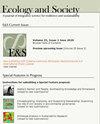多元文化认同在澳大利亚墨尔本城市森林感知价值中的作用及其对城市生态系统研究和实践的影响
IF 3.2
2区 社会学
Q1 ECOLOGY
引用次数: 0
摘要
城市自然管理通常以一个占主导地位的文化群体所表达的最常见、经常提到或容易引起的观念为指导。从长远来看,这不太可能鼓励广泛的社区支持或促进城市自然管理。考虑代表不同文化身份的人们如何看待城市自然的价值是满足不同社区需求的关键。在这项研究中,我们探讨了非澳大利亚出生的人,说非英语语言的人(LOTE),以及自认为说少数民族语言的人,如何看待城市树木遗址、这些遗址的树木和这些遗址的野生动物的价值。我们使用拦截问卷来收集经验感知数据,在12个不同的地点,包括公园和街道,位于澳大利亚维多利亚州的大墨尔本地区及其附近,这是一个种族文化多元化的城市地区。我们使用基于偶然性和回归的程序分析了2年来收集的1127份回复。我们发现,非出生在澳大利亚的人认为这些地点的树木和树木的重要性高于其他受访者,而LOTE受访者认为这些地点的树木和树木的重要性低于其他受访者。此外,与其他受访者相比,LOTE和一些少数语言受访者将更多的心理主题(即减轻压力,感觉良好)与树木网站联系在一起。这些差异解释了其他认知、行为和社会生态背景因素的影响,如自然相关性、树木知识、接触树木、人口统计学和地点类型(即公园或街道)。我们讨论了这些结果对考虑城市中不同文化社区的城市自然研究的意义,包括整合文化多样性作为对社会经济模式的主要考虑的补充,以理解城市自然动态,考虑冲突的价值观,以及更好地与这些社区沟通和参与。本文章由计算机程序翻译,如有差异,请以英文原文为准。
The role of diverse cultural identities in the perceived value of urban forests in Melbourne, Australia, and implications for urban ecosystem research and practice
Urban nature management is usually guided by the most common, frequently mentioned, or easily elicited perceptions expressed by a dominant cultural group. This is unlikely to encourage widespread community support or foster urban nature stewardship in the long run. Considering how people representing diverse cultural identities perceive the value of urban nature is key to meeting diverse community needs. In this study we explore how people not born in Australia, people who speak a language-other-than-English (LOTE), and people who self-identify as speaking a minority language, perceive the value of urban treed sites, trees at these sites, and the wildlife at these sites. We used an intercept questionnaire to collect empirical perception data, delivered in 12 different sites, including parks and streets, located in and near the Greater Melbourne Area, an ethno-culturally diverse urban area in the state of Victoria, Australia. We analyzed 1127 responses collected over 2 years using contingency- and regression-based procedures. We found that people who were not born in Australia rated the importance of treed sites and trees at these sites higher than other respondents, and LOTE respondents rated the importance of treed sites and trees at these sites lower than other respondents. Also, LOTE and some language minority respondents associated more psychological themes (i.e., stress reduction, feeling good) with treed sites than other respondents. These differences account for the influence of other cognitive, behavioral, and social-ecological context factors, such as nature relatedness, knowledge of trees, exposure to trees, demographics, and type of site (i.e., parks or streets). We discuss what these results mean for urban nature research with consideration of diverse cultural communities in cities, including integrating cultural diversity as a complement to the dominant consideration of socioeconomic patterns for understanding urban nature dynamics, accounting for conflicting values, and better communicating with and engaging these communities.
求助全文
通过发布文献求助,成功后即可免费获取论文全文。
去求助
来源期刊

Ecology and Society
环境科学-生态学
CiteScore
6.20
自引率
4.90%
发文量
109
审稿时长
3 months
期刊介绍:
Ecology and Society is an electronic, peer-reviewed, multi-disciplinary journal devoted to the rapid dissemination of current research. Manuscript submission, peer review, and publication are all handled on the Internet. Software developed for the journal automates all clerical steps during peer review, facilitates a double-blind peer review process, and allows authors and editors to follow the progress of peer review on the Internet. As articles are accepted, they are published in an "Issue in Progress." At four month intervals the Issue-in-Progress is declared a New Issue, and subscribers receive the Table of Contents of the issue via email. Our turn-around time (submission to publication) averages around 350 days.
We encourage publication of special features. Special features are comprised of a set of manuscripts that address a single theme, and include an introductory and summary manuscript. The individual contributions are published in regular issues, and the special feature manuscripts are linked through a table of contents and announced on the journal''s main page.
The journal seeks papers that are novel, integrative and written in a way that is accessible to a wide audience that includes an array of disciplines from the natural sciences, social sciences, and the humanities concerned with the relationship between society and the life-supporting ecosystems on which human wellbeing ultimately depends.
 求助内容:
求助内容: 应助结果提醒方式:
应助结果提醒方式:


